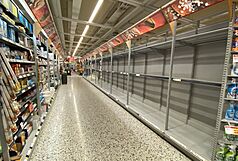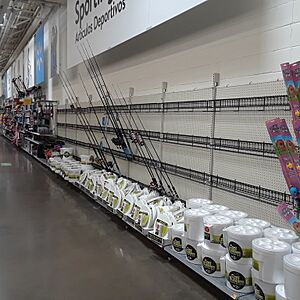Panic buying facts for kids
Panic buying happens when people suddenly buy a lot more of something than they usually would. This often occurs because they expect a disaster or a big price increase. They might also think a product will become hard to find.
This type of buying can happen before or after a real problem, or even just when people think a problem might happen. It's like when everyone rushes to buy milk before a big snowstorm.
When people panic buy, it can make things truly scarce, even if there wasn't a real shortage to begin with. This is like a self-fulfilling prophecy. If everyone thinks there won't be enough, and they all buy extra, then there really won't be enough.
People might panic buy for a few reasons. They might feel worried about a health crisis or a lack of products. Fear of the unknown can also make them feel stressed. Buying things can make them feel more in control and less anxious. Also, what friends and family do can influence someone to panic buy.
Contents
Why People Panic Buy
Panic buying is a type of herd behavior. This means people start doing something because others are doing it. It's like a trend, but for buying things. When many people start buying a lot of one item, others might feel they need to do the same. This happens even if they don't really need the item.
Experts who study how people spend money are interested in panic buying. They look at how groups of people act. This includes things like new trends, how the stock market moves, or when people rush to buy everyday items. It also covers when people collect and store large amounts of goods, known as hoarding.
Past Examples of Panic Buying
Panic buying has happened many times throughout history. Here are some examples:
- World Wars: During the First World War (1914-1918) and the Second World War (1939-1945), people often bought extra food and supplies. They worried about shortages during wartime.
- Spanish Flu (1918-1919): During this global sickness, people rushed to buy medicines. Sales of some remedies, like Vicks VapoRub, greatly increased.
- Austrian Hyperinflation (1922): In Austria, money quickly lost its value. People panic bought food and hoarded it. This continued until a plan helped prevent the economy from collapsing.
- Cuban Missile Crisis (1962): When there was a serious threat of war, Americans panic bought canned foods.
- Toilet Paper Panic (1973): In the United States, there was a strange panic where people bought huge amounts of toilet paper.
- Oil Crisis (1979): A shortage of oil led to panic buying of fuel, especially in Japan.
- New Coke (1985): When Coca-Cola changed its recipe, many people rushed to buy the original Coke before it was gone.
- Year 2000 Problem: Some people worried about computers failing at the year 2000. They bought extra food and supplies.
- September 11 Attacks (2001): After these attacks, people panic bought metals, gold, and oil on world markets.
- SARS Outbreak (2003): During the SARS sickness, people in China panic bought many items. These included salt, rice, vinegar, cooking oil, antibiotics, face masks, and traditional Chinese medicines.
- UK Fuel Protests (2000, 2005): Protests about fuel prices led to people rushing to fill up their cars.
- Jilin Chemical Plant Explosions (2005): After a chemical plant explosion in China, people panic bought water and food.
- US Ammunition Shortage (2008-2016): Gun owners bought a lot of ammunition. They feared new gun control laws under President Barack Obama. This caused shortages.
- Venezuelan Economic Crisis (2013): Venezuela faced shortages of basic goods like toilet paper and food. The government even took over a toilet paper factory.
- Dakazo (2013): In Venezuela, the president told people to empty stores. This led to widespread looting and empty shelves.
- UK Fuel Supply Crisis (2021): A lack of truck drivers caused panic buying of petrol in the United Kingdom. Many gas stations ran out of fuel.
- Pacific Northwest Floods (2021): Floods in Canada caused people to panic buy groceries.
- IKEA Russia Closures (2022): When IKEA announced it would close its stores in Russia, people rushed to buy furniture and home items. There were long lines.
- Malaysian Water Shortage (2023): People in two Malaysian states panic bought bottled water. This happened because of a short interruption in tap water supply.
- Fukushima Water Release (2023): After Japan released treated water from a nuclear plant, people in China panic bought salt and radiation detectors. They were worried about radiation.
Panic Buying During the COVID-19 Pandemic
Panic buying became a huge worldwide event in early 2020. This was during the start of the COVID-19 pandemic. It continued in smaller waves during lockdowns around the world.
Stores everywhere ran out of items like:
- Face masks
- Food
- Bottled water
- Milk
- Toilet paper
- Hand sanitizer
- Rubbing alcohol
- Antibacterial wipes
- Painkillers
Because of this, many stores had to limit how much of these items people could buy.
Online stores like eBay and Amazon also had problems. Some sellers tried to charge very high prices for these items. This is called price gouging. Amazon stopped these sellers and limited who could buy certain items. Only healthcare workers and government groups could buy things like thermometers and ventilators. People even panic rented self-storage units.
The massive buying of toilet paper really confused many people. Pictures of empty toilet paper shelves were shared all over social media. This happened in countries like Australia, the United States, the United Kingdom, Canada, Singapore, Hong Kong, and Japan. In Australia, two women even got into a fight over toilet paper at a supermarket. The Prime Minister of Australia, Scott Morrison, asked people to "stop it."
Studies showed that social media played a big part in making people anxious and causing panic. Many posts about toilet paper panic buying were negative. They showed anger or frustration. This negativity could have made more people feel anxious and scared. It might have caused a snowball effect. This means more and more people joined in, encouraged by pictures and videos of empty shelves and people fighting over toilet paper.
Gallery
-
Shoppers at a Walmart in Mexico City panic buying canned food during the 2009 flu pandemic
-
Shoppers in London panic buying canned food and toilet paper during the COVID-19 pandemic
-
Panic buying at the Giant supermarket in Franklin Farm, Virginia, during the COVID-19 pandemic in March 2020
See also
- Panic selling
- Revenge buying
- Stock market crash
- Economic bubble
- Mass hysteria
- Hoarding
- Panic room









